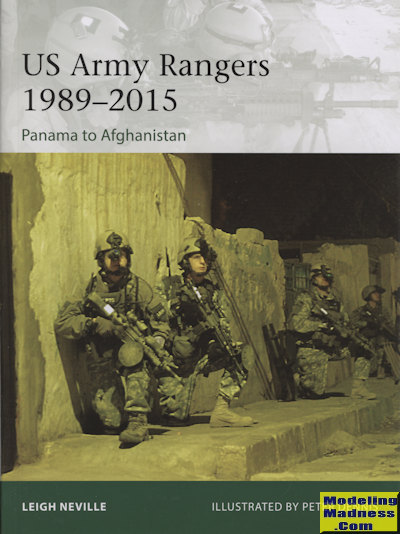 One
of Osprey's earliest books in the Elite series covered the US Army Rangers from
its inception until about 1987. This one picks up where the other left off. In
line with books in the series, there is a section on the history of the Rangers,
which I found to be rather splintered as the unit was organized in preparation
for WWII then disbanded, then reorganized again for Korea only to be disbanded
again and picked back up prior to the US commitment to Vietnam.
One
of Osprey's earliest books in the Elite series covered the US Army Rangers from
its inception until about 1987. This one picks up where the other left off. In
line with books in the series, there is a section on the history of the Rangers,
which I found to be rather splintered as the unit was organized in preparation
for WWII then disbanded, then reorganized again for Korea only to be disbanded
again and picked back up prior to the US commitment to Vietnam.
During all this time, the mission of the unit
changed to meet the requirements of the day. The current unit, has been provided
with the lineage going back to Merrill's Marauders who earned their reputation
from the fighting in Burma during WWII. Then the purpose of the unit was to be
planted behind the lines and cause as much destruction and disruption as
possible to draw enemy troops from the front lines.
Today's Rangers are much more like the British SAS
in that their primary mission is to capture enemy air fields and destroy enemy
equipment. As such, the training requirements have changed to meet the current
mission standards. The unit still expects the very best soldiers and the
rejection rate for those applying is still quite high. They operate specialized
equipment and their tactics are also rather different from the norm. In the most
part, today's Rangers are partnered with the 160 SOAR helicopter unit who
operate MH-6 and MH-47 helos.
The book covers five major operational theaters.
The first is the invasion of Panama in 1989. During this operation, losses were
quite light and the opposition was not as heavy as expected, allowing the
Rangers to meet their goals in a relatively short period of time. The next was
Desert Storm in 1991. Here the unit did not have the sort of role expected as
the general in charge, Schwartzkopf, did not feel they had a part to play.
However, they did carry out an operation in debilitating Iraqi communications
stations in the south western part of the country near Jordan.
Then there was Somalia in 1993. Here the unit
performed admirably under very trying conditions, though the overall mission was
a failure.
The next two operations are quite recent and were
very long lasting. First is the Afghan war from 2001 until the present day. The
other was the Iraq war from 2003-2010. In both cases, the Rangers were in the
forefront of the fighting, this time using their skills to eliminate insurgents
and helping to train local military units to do the same, with varying levels of
success.
You'd expect a lot of 'war stories' and you get
them. These episodes bring to light how difficult many of these operations
really were and how they affected the course of the conflict. A section on the
various weapons and equipment used is also included. What struck me the most is
how heavily armed and protected today's soldiers really are. A WWII Ranger could
only look on in envy at all the goodies available to today's forces. In fact,
like many modern soldiers, they tend to look like something out of science
fiction from a few decades back, thanks to all the electronic enhancements
available to them. However, this equipment is quite useful in allowing the
individual to perform their assignment and live through it.
In all, this book makes for an interesting read and
provides insight into one of America's premier fighting units. A book that you
really will enjoy reading.
June 2016
For more on the complete line of Osprey books,
visit www.ospreypublishing.com.
If you would like your product reviewed fairly and
fairly quickly, please contact
the editor or see other details in the Note to
Contributors.
 One
of Osprey's earliest books in the Elite series covered the US Army Rangers from
its inception until about 1987. This one picks up where the other left off. In
line with books in the series, there is a section on the history of the Rangers,
which I found to be rather splintered as the unit was organized in preparation
for WWII then disbanded, then reorganized again for Korea only to be disbanded
again and picked back up prior to the US commitment to Vietnam.
One
of Osprey's earliest books in the Elite series covered the US Army Rangers from
its inception until about 1987. This one picks up where the other left off. In
line with books in the series, there is a section on the history of the Rangers,
which I found to be rather splintered as the unit was organized in preparation
for WWII then disbanded, then reorganized again for Korea only to be disbanded
again and picked back up prior to the US commitment to Vietnam.